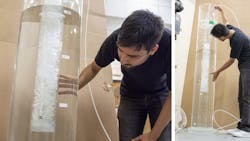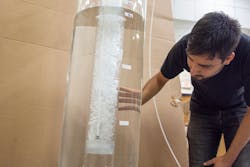3D-Printed Metal Gas Sparger Head Rises to the Top
Geothermal resources are reservoirs of hot liquid below the Earth’s surface. When engineers drill wells into these reservoirs, they are able to funnel steam and brine to the surface and generate electricity.
The two go-to methods for bringing geothermal fluids to the surface—shaft pump or a submersible pump—are not without limitations. But the limitations spur opportunities for investing in new technologies for harvesting geothermal energy and are the impetus behind a new airlift approach to optimize current geothermal pump technologies.
Associate professor Terence Musho and Berry Chair Emeritus Nigel Clark in the Statler College of Engineering and Mineral Resources at the University of West Virginia devised a new method that employs a 3D-printed device—a sparger head—to generate bubbles and lift water to the surface.
Their novel entry employs a method for bringing fluids to the surface by injecting air deep within the well and allowing the air to rise through the geothermal fluids. Air bubbles rise to the top of the well due to the difference in density. There is an exchange of momentum with the surrounding fluid, explained the engineers, who are competing for the American-Made Geothermal Manufacturing Prize (Geothermal Prize), a challenge that incentivizes additive manufactured geothermal innovations, from concept to prototype testing in two years through an accelerated schedule.
Once air is injected deep into a geothermal well, it rises to interact with geothermal fluids. As the air bubbles rise to the top, an exchange in momentum causes the geothermal fluids to rise, explained the researchers in this video:
Musho likened the technology’s mechanism to an automatic drip coffee maker. Typically, water boils and travels up a tube to the top, he said, but rather than boiling the water, this method injects air into the water relying on the same buoyancy force to bring fluids up to the surface.
A 3D sparger head was optimized using computer simulations and tested. The engineers used additive manufacturing to optimize the design of a sparger head for efficient bubble creation. The design has several important internal and external features that are critical to the creation of bubbles, they said, and it would be difficult to produce their design in the absence of an additive manufacturing approach. For instance, the spartan design was optimized using a multi-physics simulation tool that solves multi-phase fluid flow and optimizes geometry.
Efficiencies can be introduced in several ways—including controlling the size of the bubbles—but the focus was primarily on efficient means for creating bubbles, noted the engineers.
“Improved design of the sparger head for airlifts will revolutionize what the industry has been doing and eliminate the line shaft pump,” Musho said. “We can access much deeper geothermal wells, which typically have higher temperatures, which is better for direct usage and energy generation-type applications.”
Among the advantages of geothermal energy production, according to the DOE:
- Unlike wind and solar, geothermal power plants produce electricity non-stop.
- Modern plants emit no greenhouse gases and have a smaller physical footprint than other energy-generating plants.
Musho and Clark teamed up with industry collaborators Dan Hand, a professional engineer from Sustainable Engineering LLC, and Roy Mink from Mink GeoHydro Inc. for the competition.
The researchers are working within the Oak Ridge National Laboratory’s Manufacturing Demonstration Facility to use their state-of-the-art 3D metal printers.
As semi-finalists of the competition, the team will make its submission for the Make Phase of the competition in November. If selected, the technology will be tested on working geothermal wells, and the Statler College team will be eligible for up to $250,000 in cash prizes and up to $50,000 in vouchers.
About the Author

Rehana Begg
Editor-in-Chief, Machine Design
As Machine Design’s content lead, Rehana Begg is tasked with elevating the voice of the design and multi-disciplinary engineer in the face of digital transformation and engineering innovation. Begg has more than 24 years of editorial experience and has spent the past decade in the trenches of industrial manufacturing, focusing on new technologies, manufacturing innovation and business. Her B2B career has taken her from corporate boardrooms to plant floors and underground mining stopes, covering everything from automation & IIoT, robotics, mechanical design and additive manufacturing to plant operations, maintenance, reliability and continuous improvement. Begg holds an MBA, a Master of Journalism degree, and a BA (Hons.) in Political Science. She is committed to lifelong learning and feeds her passion for innovation in publishing, transparent science and clear communication by attending relevant conferences and seminars/workshops.
Follow Rehana Begg via the following social media handles:
X: @rehanabegg
LinkedIn: @rehanabegg and @MachineDesign


